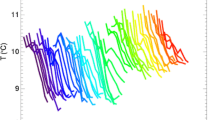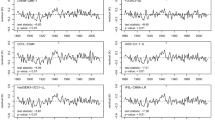Abstract
This study describes a method for deriving the time varying second order moment, or heteroscedasticity, of local daily temperature and its association to large Coupled Canadian General Circulation Models predictors. This is carried out by applying a multivariate generalized autoregressive conditional heteroscedasticity (MGARCH) approach to construct the conditional variance–covariance structure between General Circulation Models (GCMs) predictors and maximum and minimum temperature time series during 1980–2000. Two MGARCH specifications namely diagonal VECH and dynamic conditional correlation (DCC) are applied and 25 GCM predictors were selected for a bivariate temperature heteroscedastic modeling. It is observed that the conditional covariance between predictors and temperature is not very strong and mostly depends on the interaction between the random process governing temporal variation of predictors and predictants. The DCC model reveals a time varying conditional correlation between GCM predictors and temperature time series. No remarkable increasing or decreasing change is observed for correlation coefficients between GCM predictors and observed temperature during 1980–2000 while weak winter–summer seasonality is clear for both conditional covariance and correlation. Furthermore, the stationarity and nonlinearity Kwiatkowski–Phillips–Schmidt–Shin (KPSS) and Brock–Dechert–Scheinkman (BDS) tests showed that GCM predictors, temperature and their conditional correlation time series are nonlinear but stationary during 1980–2000 according to BDS and KPSS test results. However, the degree of nonlinearity of temperature time series is higher than most of the GCM predictors.










Similar content being viewed by others
References
Bollerslev T (1986) Generalized autoregressive conditional heteroscedasticity. J Econom 31:307–327
Bollerslev T (1990) Modeling the coherence in short-run nominal exchanges rates: a multivariate generalized ARCH model. Rev Econom Stat 72:498–505
Bollerslev T, Engle RF, Wooldridge JM (1988) A capital asset pricing model with time varying covariances. J Polit Econ 96:116–131
Brock WA, Dechert WD, Scheinkman JA, LeBaron B (1996) A test for independence based on the correlation dimension. Econ Rev 15:197–235
Busuioc A, Giorgi F, Bi X, Ionita M (2006) Comparison of regional climate model and statistical downscaling simulations of different winter precipitation change scenarios over Romania. Theor Appl Clim 86:101–123
Cannon AJ (2007) Nonlinear analog predictor analysis: a coupled neural network/analog model for climate downscaling. Neural Networks 20:444–453
Engle RF (1982) Autoregressive conditional heteroscedasticity with estimates of variance of United Kingdom inflation. Econometrica 50:987–1008
Engle RF (2002) Dynamic conditional correlation: a simple class of multivariate generalized autoregressive conditional heteroskedasticity models. J Bus Econ Stat 20:339–350
Fasbender D, Ouarda TBMJ (2010) Spatial Bayesian model for statistical downscaling of AOGCM to minimum and maximum daily temperatures. J Clim 23:5222–5242. doi:10.1175/2010JCLI3415.1
Fischer M, Dewitte B, Maitrepierre L (2004) A non-linear statistical downscaling model: El Nino/Southern Oscillation impact on precipitation over New Caledonia. Geophys Res Lett 31:L16204. doi:10.1029/2004GL020112
Fowler HJ, Blenkisop S, Tebaldi C (2007) Review: linking climate change modeling to impact studies: recent advances in downscaling techniques for hydrological modeling. Int J Clim 27:1547–1578
Francq C, Zakoian JM (2010) GARCH models structure, statistical inference and financial applications. Wiley, New York
Hammami D, Lee TS, Ouarda TBMJ, Lee J (2012) Predictor selection for downscaling GCM data with LASSO. J Geophys Res Atmos 117. doi:10.1029/2012JD017864
Herrera E, Ouarda TBMJ, Bobée B (2006) Méthodes de désagrégation appliquées aux Modèles du Climat Global Atmosphère-Océan (MCGAO). Revue des sciences de l’eau 19:297–312
Hessami M, Gachon P, Ouarda TBMJ, St-Hilaire A (2008) Automated regression-based statistical downscaling tool. Environ Model Softw 23:813–834
Huth R (2004) Sensitivity of local daily temperature change estimates to the selection of downscaling models and predictors. J Clim 17:649–652
Jeong DI, St-Hilaire A, Ouarda TBMJ, Gachon P (2012a) CGCM3 predictors used for daily temperature and precipitation downscaling in Southern Quebec, Canada. Theor Appl Clim 107:389–406
Jeong DI, St-Hilaire A, Ouarda TBMJ, Gachon P (2012b) Multisite statistical downscaling model for daily precipitation combined by multivariate multiple linear regression and stochastic weather generator. Clim Change 114:567–591
Kwiatkowski D, Phillips PCB, Schmidt P, Shin Y (1992) Testing the null of stationarity against the alternative of a unit root: how sure are we that economic time series have a unit root? J. Econom 54:159–178
Lahrech A, Sylwester K (2011) U.S. and Latin American stock market linkages. J Int Money Financ 30:1341–1357
Laux P, Vogl S, Qiu W, Knoche HR, Kunstmann H (2011) Copula-based statistical re_nement of precipitation in RCM simulations over complex terrain. Hydrol Earth Syst Sci 15:2401–2419
Miksovsky J, Raidl A (2005) Testing the performance of three nonlinear methods of time series analysis for prediction and downscaling of European daily temperatures. Nonlinear Process Geophys 12:979–991
Miksovsky J, Raidl A (2006) Testing for nonlinearity in European climatic time series by the method of surrogate data. Theor Appl Clim 83:21–33
Oshima N, Kato H, Kadokura S (2002) An application of statistical downscaling to estimate surface air temperature in Japan. J Geophys Res Atmos 107. doi:10.1029/2001JD000762
DAI CGCM3 Predictors (2008) Sets of predictor variables derived from CGCM3 T47 and NCEP/NCAR reanalysis, version 1.1 April 2008, Montreal, 15 pp
Schoof JT, Pryor SC (2001) Downscaling temperature and precipitation: a comparison of regression-based methods and artificial neural networks. Int J Clim 7:773–790
Vincent LA, Zhang X, Bonsal BR, Hogg WD (2002) Homogenization of daily temperatures over Canada. J Clim 15:1322–1334
Vrac M, Marbaix P, Paillard D, Naveau P (2007) Non-linear statistical downscaling of present and LGM precipitation and temperature over Europe. Clim Past 4:669–682
Wang W (2006) Stochasticity, nonlinearity and forecasting of streamflow processes. Deft University Press, Amsterdam, 2006, ISBN 1-58603-621-1
Wilby RL, Dawson CW, Barrow EM (2002) SDSM—a decision support tool for the assessment of regional climate change impacts. Environ Model Softw 17:147–159
Acknowledgments
The financial support of this study from the Natural Sciences and Engineering Research Council (NSERC) of Canada and the Canada Research Chair (CRC) Program is highly acknowledged.
Author information
Authors and Affiliations
Corresponding author
Rights and permissions
About this article
Cite this article
Modarres, R., Ouarda, T.B.M.J. A generalized conditional heteroscedastic model for temperature downscaling. Clim Dyn 43, 2629–2649 (2014). https://doi.org/10.1007/s00382-014-2076-x
Received:
Accepted:
Published:
Issue Date:
DOI: https://doi.org/10.1007/s00382-014-2076-x




